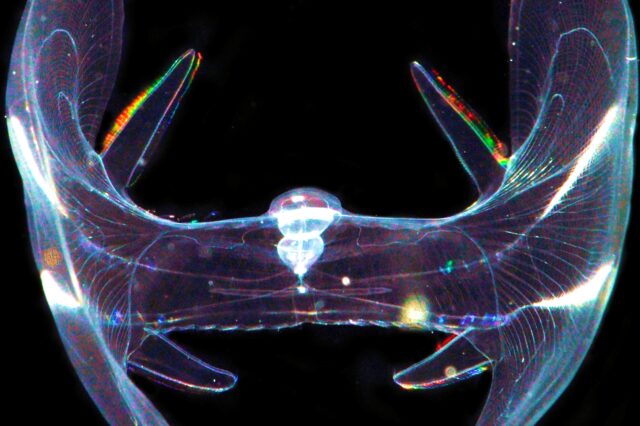Genomic study of comb jellies overturns long-held views about the animal tree of life

A University of Florida researcher and his colleagues studying the genomics of a ghostly group of predatory sea creatures called ctenophores have changed long-held notions of the evolution of neurons and the relationships between animal lineages.
These gelatinous animals, also known as comb jellies, populate oceans all over the world, and Leonid Moroz, Ph.D., a distinguished professor of neuroscience, genetics, biology and chemistry in the UF College of Medicine and his colleagues traveled the open oceans from the Caribbean to the Antarctic to collect and sequence the largest diversity of specimens so far and examine their genomes for this study.
“It turns out that there are many ways to make a neuron, and many ways to make a brain,” said Moroz, who is based at the Whitney Laboratory for Marine Bioscience in St. Augustine, Florida. Moroz, Gustav Pauley, curator of the Florida Museum of Natural History, and the rest of the UF team worked with computer scientists Nathan Whelan, Kenneth Halanych and Kevin Kocot at Auburn University, and their findings were published in the journal Nature Ecology and Evolution.
Evolutionary biologists trying to sort out the branches of the tree of life have placed all animals into five groups called clades. Three of these groups contain creatures that have a nervous system, with humans and comb jellies in two of these different groups. For many years, scientists thought these three groups formed their own group, which gave rise to the central nervous system that appears to different degrees in all the animals in a linear fashion. This would mean the simple nervous system of the comb jellies might resemble a precursor to the more complex nervous system of humans, flies or octopoti.
The work of Moroz and his colleagues shows, instead, the comb jelly group developed neurons independently of the rest of animals.
“This is a big conceptual leap that will rewrite textbooks,” Moroz said. He likened the relationship to that of building a house — you can build the structure using bricks, stone or wood, and you still have a house. “This confirms that even the most complex animal organs, such as brains, may have evolved independently.”
Collecting information on comb jellies has proved challenging until now because the fragile creatures live in the open ocean far from land, making it challenging to find and study enough species to develop accurate genomic data. So Moroz and his colleagues worked with the International SeaKeepers Society and private boat owners to travel to remote areas of the ocean to collect comb jellies and sequence genomic information from 27 novel species.
“If you have data on only a few species, the model might not be very good. So, we collected a diversity of species,” Moroz said.
The genomic information obtained provided a molecular “history” of relationships that can help scientists better understand how comb jellies relate to one another, and how they relate to other animals, including humans.
Their findings cast aside the hundred-year-old perception that “simpler” organisms, such as sponges without neurons, muscles or any detectable tissue organization, are at the very base of the animal tree of life, Moroz said.
“In contrast, strong evidence has now been obtained that such complex creatures as ctenophores might represent the earliest surviving lineage of animals on our planet,” he said.
The reconstruction of animal relationships outlined in this paper also outlines unique opportunities for synthetic biology, and novel insights into regeneration medicine and treatment of complex neurological disorders, Moroz said.